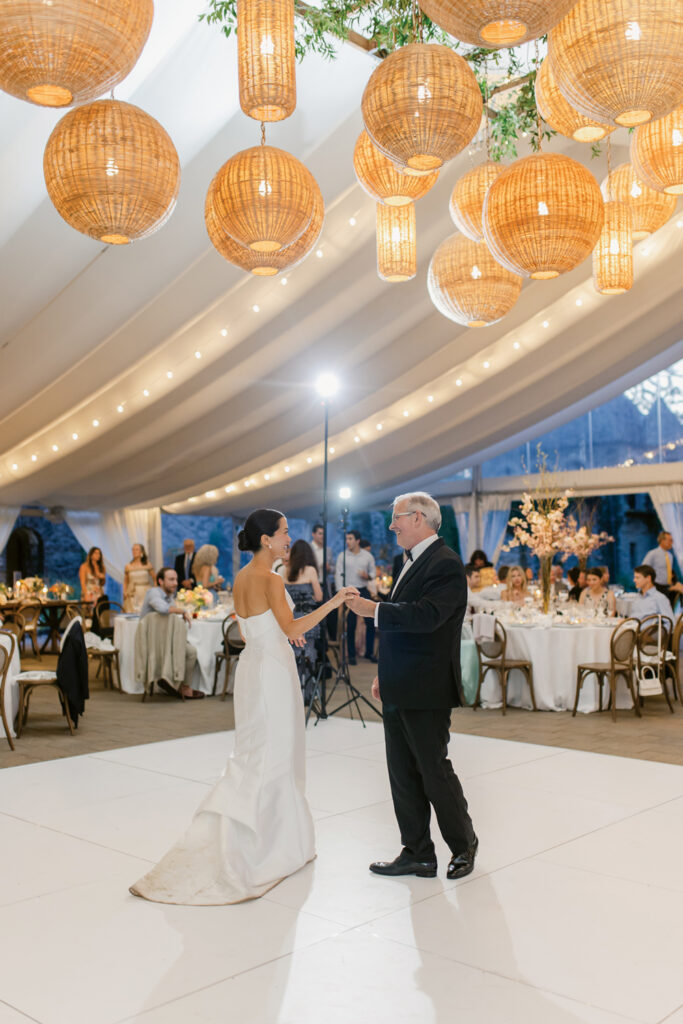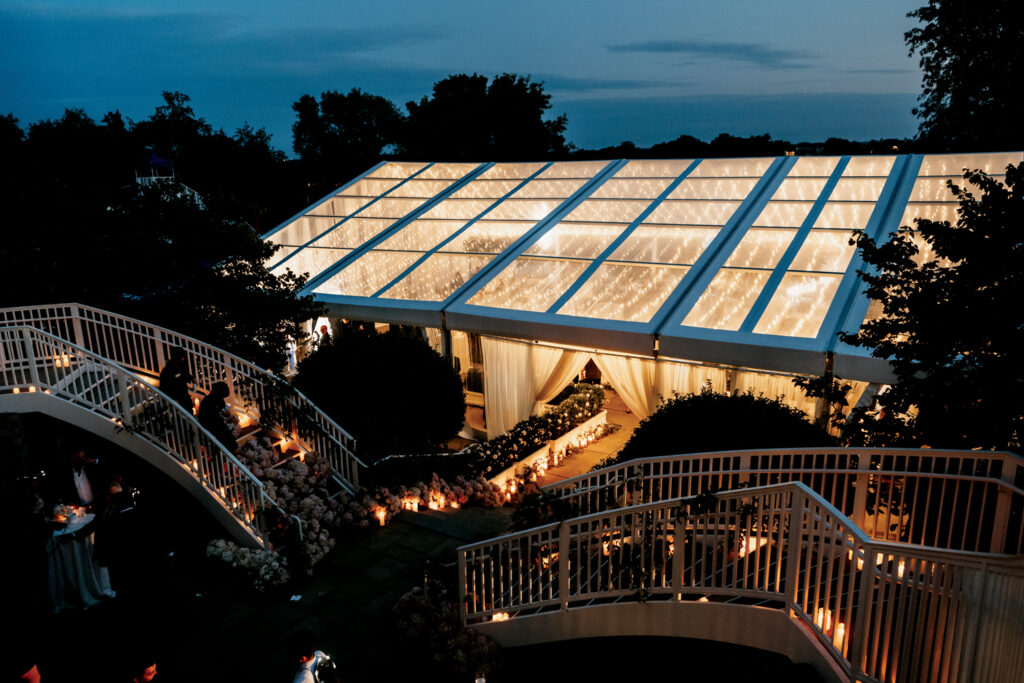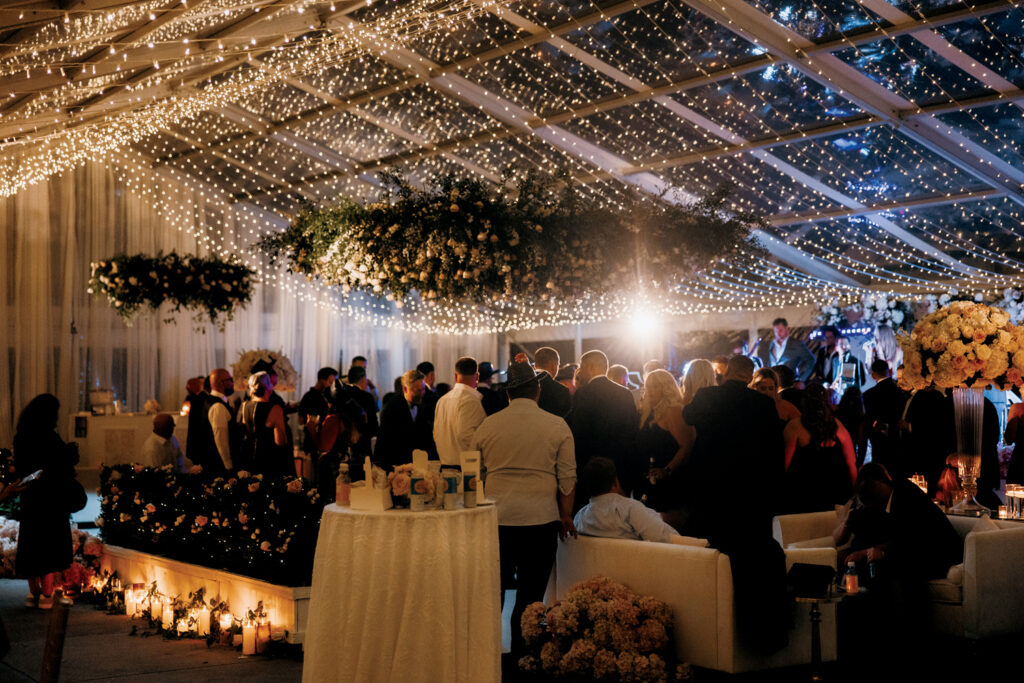Lighting is crucial for setting the desired mood for any event, whether it’s providing theatrical flair or showcasing centerpieces or even lighting walkways to ensure guests’ safety. Today’s lighting options seem limitless, ranging from fairy lights and pendants to classic or contemporary chandeliers. As technology improves, specialty lighting companies can do more than ever, often more efficiently.
What’s in and what’s out for 2025
Chandeliers are timeless and continue to be a popular choice for any event. From elegant crystal to contemporary black, there’s an astounding variety for clients to choose from these days, according to Randy Scheib, event services manager with All On Productions in Cincinnati, Ohio.
“As much as they are functional, chandeliers are also decor elements,” says Patrick Theriot, CEO and director of sales at See-Hear Productions in Covington, La. “They’re a staple, a classic.”
More affordable popular options include smaller fixtures or fairy lights, says Adam Welz, president of PHOS Events in Plymouth, Minn. “Shades, pendants and lanterns bring a stylish, intimate touch with versatility in placement and theme customization,” he says. “Delicate strands of fairy lights draped across ceilings, wrapped around poles or incorporated into centerpieces add a magical, whimsical touch.”
Scheib, however, says he would like to see less use of twinkle lights and string lights or see them designed in different ways. As a less costly option to create a romantic mood, he expects demand will continue, but notes that they’re labor-intensive to install.
Theriot says clients have shown waning interest in twinkle lights, but cafe and bistro lights remain popular choices.
Styles such as rattan pendants and disco balls also are finally fading in popularity. “They’ve been done so much,” says Welz. “People shift to the new hot trends and styles they see on Pinterest.”

Considerations when choosing lighting
When thinking about events—particularly weddings—clients tend to focus on items such as food, flowers and music. Lighting often is overlooked until an event planner brings it up. Then, depending on the client’s vision and budget for the event, it could be time to consult with specialty lighting experts to help plan and establish a lighting budget. Scheib says, “If a client tells me they haven’t set a budget, I start with the basics, and we can build from there.”
There are a number of details to be considered when designing lighting for an event. Will it take place during the day or night? What type of event? What sort of mood or theme?
Scheib cautions about a common mistake of using too much light. “At an event like a wedding dinner, the goal is generally a more subdued event,” he says. “Too much light could destroy that mood.”
To ensure perfect lighting, dimmers are essential to adjust lighting intensity. They make transitions from bright light to soft and intimate light easy, with the necessary flexibility to maintain an event’s ambiance. Welz says, “There’s no such thing as over-lighting as long as it’s done right and it’s dimmable.”
The tent type and size matter, too. Different lighting is used in a small pole tent than is used in a large-structure tent. “A daytime event in a sailcloth tent with a translucent top will have diffused light,” says Scheib. “We may not need to add much artificial lighting.” Conversely, he says, control of the lights inside and outside the tent for evening events is essential and best done by dimmers.
It’s also important to consider whether the event has a fun, classy, contemporary or iconic style, for example. “A rattan pendant versus a chandelier drastically changes the style,” says Welz. Floral arrangements and color schemes also influence lighting decisions.
At the high end of event clientele, budget may not be a concern. Theriot says, “The majority of our clients are more results driven in their events. They ask us for recommendations about what will look best for their event.” Returning clients may request that the lighting be similar to an event they held before.
“Our job is to determine how well we can hide the light fixtures and equipment, and balance that with the right and adequate light for the event,” says Theriot. Drapes, strategic rigging and magnetic fixtures help camouflage wires and cords.

To add color, impact, depth and drama, specialty lighting companies have the expertise and inventory to layer different lighting types and adjust their intensity. For general illumination, ambient lighting such as string lights or chandeliers work well. Uplights and pin spots provide accent lighting, while task lighting is more suitable for functional areas such as food stations or bars. Decorative lighting, with lanterns and fairy lights, for example, adds flair.
Scheib says, “Layering and texturing are on point, from the landscaping and walkways outside to all the indoor details.”
Welz agrees, noting that layering with uplighting and chandeliers is a good place to start as both elements create an impact.
Scheib also likes pin spots, especially battery-operated versions, which help show guests everything they should see—those costly details their hosts paid for. The professionals advise allocating money for featured items such as centerpieces as well as the lighting to show them off.
“If you’re willing to spend $500 for a rose-ball centerpiece, be sure you can afford $100 to show it off with lighting,” Theriot says. “You want your guests, and their cameras, to see everything.”
Operational considerations
As with any vendor, the lighting provider needs to be consulted on their power requirements for the event. Over the past 10 years, however, lighting companies have seen a definite shift to battery-powered lights. “They have revolutionized the time and labor for setup,” Scheib says. “An event that might previously have required four hours to set up can now take an hour with battery-operated lighting.”
Welz agrees and finds that battery power is almost fully dependable now. “We still like to use other power options, too; for example, with perimeter lights.”

For safe and efficient installations, PHOS also relies on battery-powered winches to lift lighting into place. The portable winches reduce the risk of accidents compared to manual lifting, according to Welz. “They’re especially useful for handling heavier fixtures or when working with higher ceilings,” he says.
Solar-powered lighting has improved tremendously in recent years, but Theriot and Scheib feel that the technology still isn’t reliable enough to be used at events, and neither recommends it to clients. As Theriot says, you just can’t always count on the sun.
However, PHOS has successfully used solar lights for tent perimeters, walkways and stairways, and to highlight trees or features. “Solar lights can do a pretty good job, especially for exterior lighting,” Welz says. “They provide an inexpensive way to provide wireless, outdoor lighting.” But he agrees that powered solutions, including battery power, are often better ways to go.
Go with the pros
Lighting completes an event, like icing does for a cake. It helps create atmosphere and establish a level of visual importance to spaces. Tent and other equipment rental companies may be able to assist with base-level lighting. Specialty lighting companies, however, have larger arsenals of lighting options and highly trained, experience technicians to create truly superb events. To light an event like a professional, hire the professional and get on their schedule at least six months in advance.
Linda McDonald is a freelance writer based in Minneapolis, Minn.
For brides and grooms with smaller budgets or who choose DIY to save money, these pro tips can help:
- Create warmth with less-expensive candle lights and uplights.
- For maximum coverage, choose cafe lighting over chandeliers.
- Make lighting flow with the floor plan to define spaces.
- Rent quality gear, including dimmers, and find out how to use it.
- Choose battery-powered lights.
- Match the color temperature of lighting elements, including bulbs. For example, avoid mixing warm incandescent lights with cool LEDs, unless it’s intended for effect. Cameras will pick up inconsistencies.







Leave A Comment